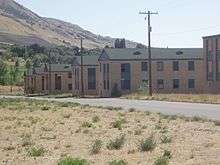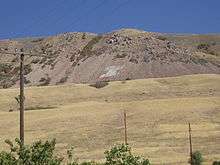Intermountain Indian School
The Intermountain Indian School (1950–1984) was a Native American boarding school in Brigham City, Utah.
| Intermountain Indian School | |
|---|---|
 A few vacant buildings at the Intermountain Indian School | |
| Location | |
| , , 84302 | |
| Coordinates | 41.491047°N 112.0102233°W |
| Information | |
| School type | Native American boarding school |
| Founded | 1949 |
| Opened | January 1950 |
| Status | Closed |
| Closed | 1984 |
| Grades | Elementary through high school |
| Enrollment | 2,150 |
History
The Intermountain Indian School was originally the Bushnell Army Hospital, which was open from 1942 to 1946 and served wounded soldiers of World War II. The land was donated by the city to the Federal government so Brigham City could get the hospital. Doctors, nurses, military personnel, wounded patients, and their families arrived in Brigham City to work at Bushnell. After the hospital's closure, the buildings sat empty for a short period while the city decided what should be done with the land. The last patient was discharged 22 June 1946. At its peak, the hospital was a community of some 6,000 inhabitants, including patients, assigned military personnel, and civilian employees. The first patient was admitted on 10 October 1942.[1]
In 1948, Brigham City got a proposal for an Indian school. The estimate for remodeling, new construction, and equipment was $3.75 million. President Harry Truman signed the bill allocating the money in May 1949. The superintendent and a few assistants began working on June 4, 1949, and by January 1950, 542 students were accepted at the federally run Intermountain Indian School. Since that time, the school was authorized to enroll 2,150 students. The school served Navajo children who were bused from Arizona and were taught from elementary to high school, and had its own medical facility and printing press.
In 1954, 24 students graduated from the school, and by 1955 that number jumped to 188. By 1981, 5,319 students had graduated.
Despite its success as a Navajo boarding school, enrollment was down in the early 70s, so the school was changed to the Intermountain Inter-Tribal School for the 1974-1975 school year. It grew to having students from nearly 100 tribes.
The school closed in 1984, after which city officials submitted a master plan in Washington, D.C. to get the 17 acres (69,000 m2) along U.S. Route 91 back from the federal government. The agreement reached was that the land would remain open space and not be used for anything other than recreation, and it was deeded back to the city.
The school today

Brigham City turned the open land into a golf course and sold the rest to fund the golf course. Objects from the buildings were sold for $100,000, and property was sold for $2.5 million. The dormitories have been turned into townhouses called "Eagle Village". A furniture store, a consulting firm, a martial arts company, and various churches all house their businesses in the former home of the Intermountain Indian School. For several decades many of the buildings stood vacant, but in early 2013 these buildings were demolished to make way for an extension of the Brigham City campus of Utah State University.[2]
For the past 20 years, former students of Intermountain have held an annual reunion the third week of July at Wheatfields Lake near Navajo, New Mexico.
Urban legends
Until recently the school was left largely deserted. This allowed local delinquents to break windows and enter to paint graffiti. Entering these buildings is done as a sort of dare. There are several urban legends concerning the buildings. The most popular are that the buildings are haunted, or that tunnels built during World War II connecting the buildings underneath are used for satanic blood filled rituals.
The School property and buildings were originally the Bushnell Army Hospital, designed specifically to treat amputees during World War II. The buildings were all connected by ramp ways for wheelchair access, including ramps between the first and second floors. Both steam heating pipes and electrical power lines ran under the ramps. The students used to speculate that during the war, they threw all the amputated limbs under the ramps. During the war the grounds were meticulously kept by German POWs. In the late 1970s and early 1980s numbers of former POWs returned to show their children and grandchildren where they spent the war. The original School classroom buildings and the school auditorium have been torn down.
See also
- USU-Brigham City
References
- Staff, "S. B. Soldier Last Patient At Bushnell Hospital, Utah - Combat Wounded Veteran Holds Distinction As Final Man at Once Busy Institution", The San Bernardino Daily Sun, San Bernardino, California, Sunday 23 June 1946, Volume 52, page 15.
- Opsahl, Kevin (February 7, 2013). "USU starts demolition of abandoned Indian School in Brigham City". The Herald Journal. Retrieved February 15, 2013.
- Kara Campbell & Katrina Brainard, "What Is That 'I'?" The Utah Statesman
External links
- Outside the Homeland: the Intermountain Indian School: Award-winning exhibition by the Brigham City Museum of Art & History (online version of the temporary exhibition)
- Photos and documents from the Intermountain Indian School Digital Collection: Utah State University
- Photos, documents, yearbooks, and historical objects from the Intermountain Indian School: Brigham City Museum of Art & History